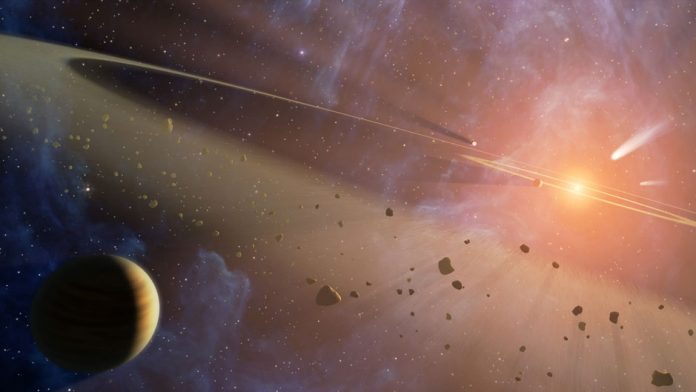Artist’s conception showing the closest known planetary system to our own: Epsilon Eridani
Image: NASA/JPL-Caltech
Scientists may be one step closer to understanding how planets form. In recent work published in Nature, researchers at NASA’s Southwest Research Institute collaborated with Canadian co-author Prof. Martin J. Duncan at Queen’s University, hypothesizing that gas giants in our solar system may have pebbles to thank for their rock-based cores.
Their simulations are the first in the world to predict the structure of our outer solar system, with two gas giants (Jupiter and Saturn), two ice giants (Uranus and Neptune), and a band of rocky debris (the Kuiper Belt).
Gas giant planets like Jupiter, Saturn, Uranus, and Neptune all have a rock core
Image: NASA/Lunar and Planetary Institute
A solar system is born from the leftover material that collapsed into a star – in our case, the sun. Young stars are surrounded by a swirling disk of gas, dust, and pebbles. The material gathers and clumps into bigger pieces, which may ultimately form planets.
It was previously well accepted that the first step to building a gas giant is the formation of a core of rock and ice, but there were two elements that scientists could not replicate with their simulations.
Firstly, these cores, which are about 10 times more massive than Earth, needed to form within 1-10 billion years, before the solar nebula dissipated, taking away the possibility of gathering their gas and ice shells. By contrast, the Earth is estimated to have formed over a period of 30-100 billion years.
Secondly, previous models assumed that pebbles grew at similar rates: dust gathered into pebbles, and pebbles collided and grew into small planetesimals. Simulations based on this idea produced hundreds of Earth-sized planets, which does not fit with what we know about our solar system: we have only 8 planets, and the massive cores of our gas and ice giants would not exist at all.
Artist’s conception of a newly formed star surrounded by disk of dust and gas; debris clumps to create rocky ‘planetesimals’ that grow to eventually form planets
Image: NASA/JPL-Caltech and University of Copenhagen/Lars Buchhave
In the new simulations, the researchers modified their model to allow pebbles to form slowly, and to give growing planetesimals the ability to interact and collide with one another.
This changed the results in two important ways: a few large rock cores could slowly gather more pebbles to increase in size, and even small differences in the sizes of these growing cores could allow the larger ones to use gravitational pull to scatter their smaller siblings out of the pebble disk, halting their growth.
This model accurately predicted the rapid growth of fewer, but more massive, planet cores.
Evolution of a star’s dust cloud: gaps appear as planets form and clear a path
Image credit: NASA/JPL-Caltech
This animation from Space.com shows real images of a young solar system.
Video courtesy of Space.com
Not loading? Try hitting refresh or going directly to Space.com











































